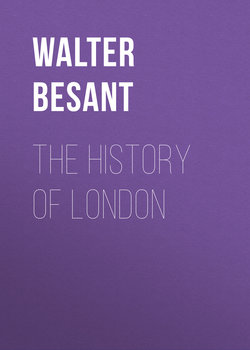Читать книгу The History of London - Walter Besant - Страница 16
16. LONDON BRIDGE
ОглавлениеPART II
Houses were erected in course of time along the Bridge on either side like a street, but with intervals; and along the roadway in the middle were chain posts to protect the passengers. As the Bridge was only 40 feet wide the houses must have been small. But they were built out at the back overhanging the river, and the roadway itself was not intended for carts or wheeled vehicles. Remember that everything was brought to the City on pack horse or pack ass. The table of Tolls sanctioned by King Edward I. makes no mention of cart or waggon at all. Men on horseback and loaded horses can get along with a very narrow road. Perhaps we may allow twelve feet for the road which gives for the houses on either side a depth of 14 feet each.
These houses were occupied chiefly by shops, most of which were 'haberdashers and traders in small wares.' Later on there were many booksellers. Paper merchants and stationers, after the Reformation, occupied the chapel. The great painter Hans Holbein lived on the Bridge and the two marine painters Peter Monamy and Dominic Serres also lived here.
The narrowness of the arches and the rush of the flowing or the ebbing tide made the 'shooting' of the Bridge a matter of great danger. The Duke of Norfolk in 1429 was thrown into the water by the capsizing of his boat and narrowly escaped with his life. Queen Henrietta, in 1628, was nearly wrecked in the same way by running into the piers while shooting the Bridge. Rubens the painter was thrown into the water in the same way.
One of the twenty arches formed a drawbridge which allowed vessels of larger size than barges to pass up the river and could be used to keep back an enemy. In this way Sir Thomas Wyatt in 1557 was kept out of London. Before this drawbridge stood a tower on the battlements of which were placed the heads of traitors and criminals. The heads of Sir William Wallace, Jack Cade, Sir Thomas More and many others were stuck up here. On the Southwark side was another tower.
The Bridge, which was the pride and boast of London, was endowed with lands for its maintenance: the rents of the houses were also collected for the same purpose: a toll was imposed on all merchandise carried across, and a Brotherhood was formed, called the Brothers of St. Thomas on the Bridge, whose duty it was to perform service in the chapel and to keep the Bridge in repair.
Repairs were always wanting: to keep some of the force of the water off the piers these were furnished with 'starlings,' i.e. at first piles driven down in front of the piers, afterwards turned into projecting buttresses of stone. Then corn mills were built in some of the openings, and in the year 1582 great waterworks were constructed at the southern end. The tower before the drawbridge was by Queen Elizabeth rebuilt and made a very splendid house – called Nonesuch House. The Fire destroyed the houses on the Bridge, some of which were not rebuilt: and in the year 1757 all the houses were removed from the Bridge.
